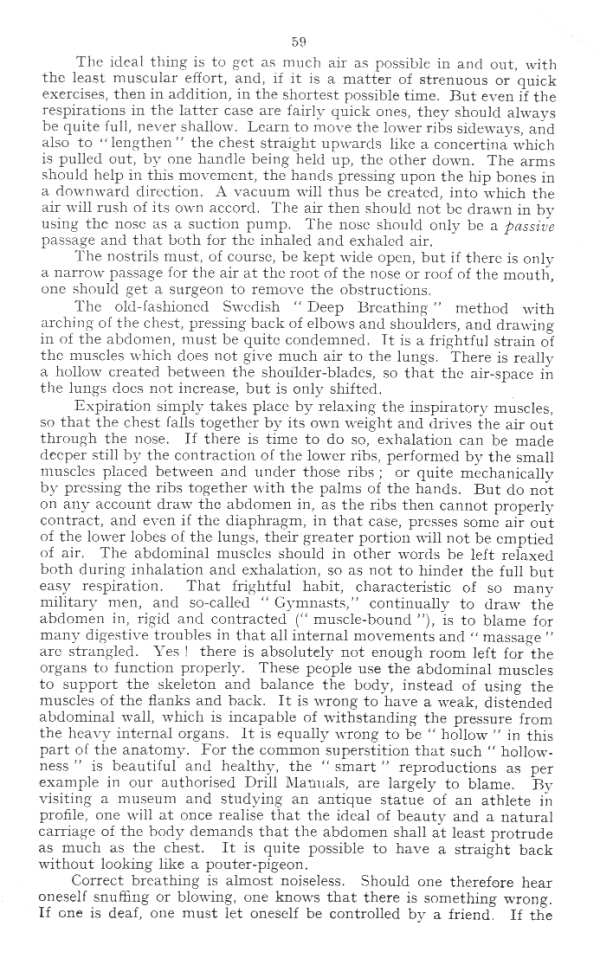system 59

59
The ideał tliing is to get as much air as possiblc in and out, with the least muscular effort, and, if lt is a matter of strenuous or quick excrcises, then in addition, in the shortest possible time. But even ii the respirations in the lattcr case are fairly quick ones, tlicy should always be quite fuli, never shallow. Leara to move the lower ribs sideways, and also to "lengthen” the chest straight upwards likc a concertina which is pulled out, by one handle being held up, tbe other down, The arms should help in this movcment, the hands pressing upon the lup bones in a dowńward dircction. A vacuum will thus be creatcd, into which the air will rush of iLs own accord. The air then should not bc drawn in by using the nose as a suction pump. The nose should only be a passne passage and that both for the inhaled and exhaled air.
The nostrils must. of course, be kept wide open, but if therc is only a narrow passage for the air at the root of the nose or roof of the mouth, one should get a surgeon to removc the obstructions.
The old-fasliioned Swcdish “ Deep Brcathing ” metliod with arching of the chest, pressing back of elbows and skouldcrs, and drawing in of the abdomen, must be quitc condemned. Tt is a frightful strain of the muscles which does not givc much air to the lungs. There is really a hollow created between the shoulder-blades, so that the air-space iii the lungs does not inerease, but is only shifted.
Expiration simply takes place by relaxing the iiispiratory muscles, so that the chest falls together by its own weight and driyes the air out through the nose. If there is time to do so, exhalation can be madę decper still by the contraction of the lower ribs, perfonned by the smali muscles placed between and under those ribs ; or quite mechanically by pressing the ribs together with the palms of the hands. But do not on any account draw the abdomen in. as the ribs then cannot properly contract. and even if the diaphragm, in that case, presses sonie air out of the lower lobes of the lungs, their greater portion will not be emptied of air. The abdominal muscles should in other words be left relaxed both during inhalation and exlialation, so as not to liindet the fuli but easy respiration. That frightful habit, characteristic of so many military men, and so-called " Cymnasts,” continually to draw the abdomen in, rigid and contracted (" muscle-bound ”), is to blame for many digestiye troubles in that all internal movements and “ massage ” arc strangled. Ves I there is absolutely not enough room left for the organs to function properly. These people use the abdominal muscles to support the skeleton and balancc the body, instead of using the muscles of the flanks and back. It is wrong to have a weak, distendcd abdominal wali, which is incapable of withstanding the pressure from the hcayy internal organs. lt is equally wrong to be " hollow ” in this part of tiie anatomy. For the common superstition that such " hollow-ness ” is beautiful and healthy. the " smart ” reproductions as per example in our authorised Drill Manuals, are largely to blame. By yisiting a museum and studying an antique statuę of an athlete in profile, one will at once realise that the ideał of beauty and a natural camage of the body demands that the abdomen shall at least protrude as much as the chest. Tt is qnite possible to have a straight back without looking hke a pouter-pigeon.
Correct brcathing is almost noiseless. Should one therefore hear oneself snufting or blowing, one knows that there is something wrong. If one is deaf, one must let oneself be controlled by a friend. If the
Wyszukiwarka
Podobne podstrony:
How to Get Your First Real Copywriting Client in..."14 Days Or Less!" Discover My Personal
2ea4d5aeeff845b5d2de02dac10e278d fi apprOTftl of the President, to make use of aoy fund hcrcafter 7
let it snow 6 6.GIacial Lace(Make 3) Ch 7, join with slip st to form a ring. Rnd 1: Ch 3. 17 dc in r
chain14 Wave Chain To get started, o pen approximately 15 jump rings, and set aside Overlap two
let it snow 4 * Iced Gingerbread(Make 3) Ch 10, join with slip st to form a ring. Rnd 1: Ch 1, 18 sc
let it snow 7 9.White Nights(Make 3) Ch 7, join with slip st to form a ring. Rnd 1: Ch 1, 18 sc in r
let it snow 3 1. Angel’s Tears(Make 3) Ch 10, join with slip st to form a ring. Rnd 1: Ch 3, 23 dc i
więcej podobnych podstron